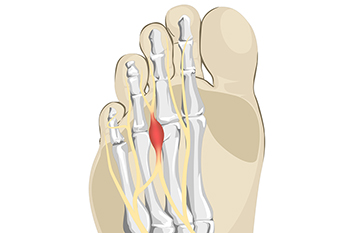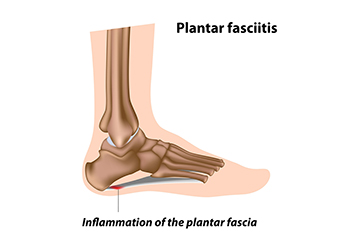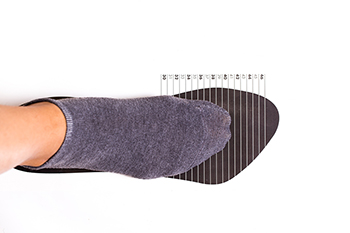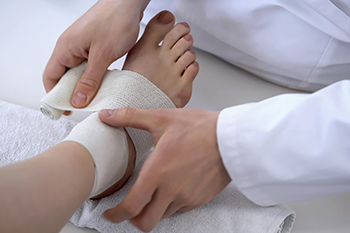Items filtered by date: January 2024
The Discomfort of Morton’s Neuroma

Morton's neuroma, a nerve disorder affecting the feet, emerges as a reality for many individuals seeking to understand the source of their discomfort. This condition is characterized by the thickening of tissues surrounding the nerves leading to the toes. It is not an actual tumor, as the name might suggest, but a response to nerve irritation and compression. Often occurring between the third and fourth toes, Morton's neuroma triggers a variety of symptoms, including sharp pain, burning sensations, and the feeling of having a pebble in the shoe. The causes of Morton's neuroma are multifaceted. Anything that exert constant pressure on the forefoot, such as wearing high-heeled shoes or engaging in certain activities, such as running, may contribute to the development of this condition. If you are experiencing any of the above symptoms, it is strongly suggested that you schedule an appointment with a podiatrist who can accurately diagnose and treat Morton’s neuroma.
Morton’s neuroma is a very uncomfortable condition to live with. If you think you have Morton’s neuroma, contact Scott Burdge, DPM of Advanced Ankle & Foot. Our doctor will attend to all of your foot care needs and answer any of your related questions.
Morton’s Neuroma
Morton's neuroma is a painful foot condition that commonly affects the areas between the second and third or third and fourth toe, although other areas of the foot are also susceptible. Morton’s neuroma is caused by an inflamed nerve in the foot that is being squeezed and aggravated by surrounding bones.
What Increases the Chances of Having Morton’s Neuroma?
- Ill-fitting high heels or shoes that add pressure to the toe or foot
- Jogging, running or any sport that involves constant impact to the foot
- Flat feet, bunions, and any other foot deformities
Morton’s neuroma is a very treatable condition. Orthotics and shoe inserts can often be used to alleviate the pain on the forefront of the feet. In more severe cases, corticosteroids can also be prescribed. In order to figure out the best treatment for your neuroma, it’s recommended to seek the care of a podiatrist who can diagnose your condition and provide different treatment options.
If you have any questions, please feel free to contact our office located in Katy, TX . We offer the newest diagnostic and treatment technologies for all your foot care needs.
Potential Relief Options for Plantar Fasciitis

Plantar fasciitis, a common foot ailment affecting people between 25 and 65 years old, results from the overloading or overstretching of the plantar fascia, which is the supportive tissue beneath the foot's arch. A podiatrist may offer a variety of treatment options tailored to manage the pain of plantar fasciitis and help toward healing. Rest and support are integral to short-term management. Utilizing a walking boot and crutches allows the foot to rest, aiding in the recovery process. Corticosteroid injections become a consideration in cases of severe pain and inflammation resistant to other conservative treatments. However, caution is warranted due to potential weakening of the plantar fascia and the risk of rupture, which can lead to chronic pain and foot flattening. Extracorporeal shockwave therapy is a noninvasive procedure used by some podiatrists to stimulate healing in plantar fascia tissue. However, its effectiveness varies among individuals. Low-level laser therapy is sometimes employed by podiatrists to reduce the pain and inflammation associated with plantar fasciitis, offering relief for up to three months. In cases where nonsurgical treatments prove insufficient, foot surgery may be considered. But it typically is reserved for situations where significant improvement has not been observed through other methods. To find out more healing from plantar fasciitis, it is suggested that you schedule an appointment with a podiatrist for an exam and treatment plan.
Plantar fasciitis is a common foot condition that is often caused by a strain injury. If you are experiencing heel pain or symptoms of plantar fasciitis, contact Scott Burdge, DPM from Advanced Ankle & Foot. Our doctor can provide the care you need to keep you pain-free and on your feet.
What Is Plantar Fasciitis?
Plantar fasciitis is one of the most common causes of heel pain. The plantar fascia is a ligament that connects your heel to the front of your foot. When this ligament becomes inflamed, plantar fasciitis is the result. If you have plantar fasciitis you will have a stabbing pain that usually occurs with your first steps in the morning. As the day progresses and you walk around more, this pain will start to disappear, but it will return after long periods of standing or sitting.
What Causes Plantar Fasciitis?
- Excessive running
- Having high arches in your feet
- Other foot issues such as flat feet
- Pregnancy (due to the sudden weight gain)
- Being on your feet very often
There are some risk factors that may make you more likely to develop plantar fasciitis compared to others. The condition most commonly affects adults between the ages of 40 and 60. It also tends to affect people who are obese because the extra pounds result in extra stress being placed on the plantar fascia.
Prevention
- Take good care of your feet – Wear shoes that have good arch support and heel cushioning.
- Maintain a healthy weight
- If you are a runner, alternate running with other sports that won’t cause heel pain
There are a variety of treatment options available for plantar fasciitis along with the pain that accompanies it. Additionally, physical therapy is a very important component in the treatment process. It is important that you meet with your podiatrist to determine which treatment option is best for you.
If you have any questions, please feel free to contact our office located in Katy, TX . We offer the newest diagnostic and treatment technologies for all your foot care needs.
Risk Factors for Ingrown Toenails in the Elderly

Ingrown toenails in the elderly can result from various risk factors. These include both anatomical and behavioral factors. Improperly trimming or tearing nails, as well as wearing tight or ill-fitting footwear, can contribute to the development of ingrown toenails. The use of shoes, especially constricting ones, is associated with an increased risk. Systemic diseases, such as diabetes and obesity, may predispose individuals to lower extremity edema, making them more susceptible to ingrown toenails. Certain medications like retinoids, oral antifungals, and cyclosporine have also been linked to the condition. Hyperhidrosis, or excessive sweating of the feet, can soften the nail and skin, making it easier for the nail to pierce the surrounding skin. Poor foot hygiene can also exacerbate this issue. Repetitive trauma from activities like running or sports can be inciting factors for ingrown toenails. Some individuals may have a genetic predisposition or a family history of ingrown toenails. Additionally, congenital malalignment of the great toenails is associated with a higher risk of developing ingrown toenails. If you are a senior and suffer from discomfort of ingrown toenails, it is suggested that you schedule regular appointments with a podiatrist to obtain proper care and learn more about preventative measures.
Ingrown toenails can become painful if they are not treated properly. For more information about ingrown toenails, contact Scott Burdge, DPM of Advanced Ankle & Foot. Our doctor can provide the care you need to keep you pain-free and on your feet.
Ingrown Toenails
Ingrown toenails occur when a toenail grows sideways into the bed of the nail, causing pain, swelling, and possibly infection.
Causes
- Bacterial infections
- Improper nail cutting such as cutting it too short or not straight across
- Trauma to the toe, such as stubbing, which causes the nail to grow back irregularly
- Ill-fitting shoes that bunch the toes too close together
- Genetic predisposition
Prevention
Because ingrown toenails are not something found outside of shoe-wearing cultures, going barefoot as often as possible will decrease the likeliness of developing ingrown toenails. Wearing proper fitting shoes and using proper cutting techniques will also help decrease your risk of developing ingrown toenails.
Treatment
Ingrown toenails are a very treatable foot condition. In minor cases, soaking the affected area in salt or antibacterial soaps will not only help with the ingrown nail itself, but also help prevent any infections from occurring. In more severe cases, surgery is an option. In either case, speaking to your podiatrist about this condition will help you get a better understanding of specific treatment options that are right for you.
If you have any questions please feel free to contact our office located in Katy, TX . We offer the newest diagnostic and treatment technologies for all your foot and ankle needs.
Are You Suffering From Nerve Damage?
Well-Fitting Shoes

Choosing appropriate footwear is essential for maintaining foot health, enhancing physical activity, and preventing injuries. Well-fitted, activity-specific shoes that address individual foot concerns and offer adequate protection to feet, legs, and joints are essential. A suitable shoe should provide cushioning through its midsole, support proper foot alignment, ensure immediate comfort, and offer a snug, yet non-restrictive fit. Shopping post-exercise or late in the day ensures shoes remain comfortable when your feet are their largest. When trying on shoes, wear the type of socks you plan to use during the activity. Have your feet measured each time you buy shoes since size can change with age, and one foot may be slightly larger. Ensure there is room for toe movement and avoid shoes that require breaking in. Walk or run a few steps to assess comfort and heel grip. Ultimately, the right shoes can alleviate foot pain, improve mobility, and contribute to an active and pain-free lifestyle. If you would like specific help in finding shoes that fit properly, it is suggested that you schedule an appointment with a podiatrist who can take into consideration your specific footwear concerns and make tailored footwear recommendations.
Finding a properly-fitting shoe is important in reducing injuries and preventing foot problems. For more information about treatment, contact Scott Burdge, DPM from Advanced Ankle & Foot. Our doctor will treat your foot and ankle needs.
Proper Shoe Fitting
A common concern when it comes to foot health, having properly fitted shoes can help prevent injuries to the foot. Out feet affect our posture and gait, which in turn affects the biomechanics and overall bodily structure. With 33 joints, 26 bones, and over 100 ligaments, the potential for serious injury is much greater than one realizes. Although the feet cease growth in adulthood, they still change shape as they mature. Here are some factors to consider when it comes to investing in proper fitting shoes:
- Be sure the shoes fit correctly right away
- Ensure the ball of your foot fits comfortably in the widest portion of the shoes
- Even though they may look fashionable, improper fitting shoes can either create adverse conditions or exacerbate existing ones you may already have
- Walk along a carpeted surface to ensure the shoes comfortably fit during normal activity
Keeping in mind how shoes fit the biomechanics of your body, properly-fitting shoes are vitally important. Fortunately, it is not difficult to acquire footwear that fits correctly. Be sure to wear shoes that support the overall structure of your body. Do your feet a favor and invest in several pairs of well-fitted shoes today.
If you have any questions please feel free to contact our office located in Katy, TX . We offer the newest diagnostic and treatment technologies for all your foot and ankle needs.
Definition and Causes of an Acute Ankle Sprain

An acute ankle sprain refers to a sudden and unexpected injury to the ligaments that support the ankle joint. These ligaments can become stretched or torn when the foot twists or turns beyond its normal range of motion. This injury often results from a misstep, an awkward landing, or a sudden change in direction, such as in sports activities. The causes of an acute ankle sprain are typically linked to excessive or forceful movements that strain the ankle ligaments. Common situations include stumbling on uneven ground, stepping off of a curb, or rolling the ankle during sports activities, such as basketball or soccer. Wearing high heels and poorly fitting footwear can also increase the risk of ankle sprains by destabilizing the ankle. Understanding the definition and causes of an acute ankle sprain is essential for both prevention and timely treatment. If you have sprained your ankle, it is strongly suggested that you consult a podiatrist who can accurately diagnose this condition, and offer treatment methods that are right for you.
Ankle sprains are common but need immediate attention. If you need your feet checked, contact Scott Burdge, DPM from Advanced Ankle & Foot. Our doctor can provide the care you need to keep you pain-free and on your feet.
How Does an Ankle Sprain Occur?
Ankle sprains take place when the ligaments in your ankle are torn or stretched beyond their limits. There are multiple ways that the ankle can become injured, including twisting or rolling over onto your ankle, putting undue stress on it, or causing trauma to the ankle itself.
What Are the Symptoms?
- Mild to moderate bruising
- Limited mobility
- Swelling
- Discoloration of the skin (depending on severity)
Preventing a Sprain
- Wearing appropriate shoes for the occasion
- Stretching before exercises and sports
- Knowing your limits
Treatment of a Sprain
Treatment of a sprain depends on the severity. Many times, people are told to rest and remain off their feet completely, while others are given an air cast. If the sprain is very severe, surgery may be required.
If you have suffered an ankle sprain previously, you may want to consider additional support such as a brace and regular exercises to strengthen the ankle.
If you have any questions please feel free to contact our office located in Katy, TX . We offer the newest diagnostic and treatment technologies for all your foot and ankle needs.




